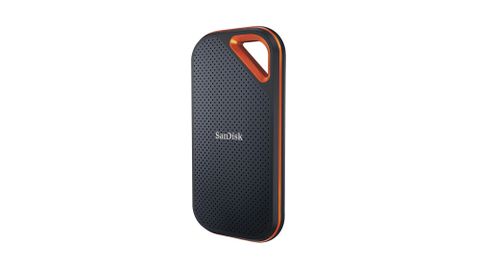IT Pro Verdict
Pros
- +
Outstanding performance
- +
Extremely portable
- +
Generous warranty
Cons
- -
Expensive
- -
Somewhat garish design
- -
No hardware encryption support
The storage industry never stands still, and drive manufacturers are in a near-constant arms race to take advantage of the latest and greatest interface protocols. The SanDisk Extreme Pro, for example, is one of the first external drives we’ve seen that uses the USB 3.2 Gen 2x2 standard, and when it’s connected to a compatible socket, it can sustain speeds of up to 20Gbits/sec.
The catch might be the “compatible socket” part – even on the newest laptops and desktops, 2x2 ports are still rare. If you don’t have one, you can plug this drive into a regular USB socket for now, and look forward to a big speed boost when you next upgrade your computer. Alternatively, if you’re using a desktop system, you can buy a PCI Express card that adds the requisite USB connector for around £30.
That’s what we did, and we don’t begrudge the investment at all. With sequential read and write rates of over 1,800MB/sec, the Extreme Pro’s performance over a Gen 2x2 connection vies with low-end NVMe drives. Multithreaded performance isn’t quite so stellar, but this SSD was still around twice as fast as drives using the older 10Gbits/sec connection. That makes it a superb choice for any outboard storage role: PCMark’s suite of storage benchmarks gave it a data disk score of 1,788, which is an excellent result that puts it firmly in the top tier of external drives for mass file transfers.
The Extreme Pro fares well in the portability stakes too. It’s smaller than most competing portable SSDs, weighs just 85g and even has some ruggedisation, thanks to a tough plastic and rubber outer. An IP55 rating promises protection against dust and splashes, and it’s backed up with a five-year warranty, which is unusually long for an external drive.
All of this makes the Extreme Pro a great choice if you’re looking for a drive you can just chuck into a bag and go. It’s ideally suited to anyone that needs high-capacity storage in the field, such as photography or video professionals. The only thing we’re ambivalent about is the showy orange trim – and we’re doubtful that even the most outdoorsy types will make use of the carabiner loop in the top corner.
It’s also slightly disappointing to note that hardware encryption isn’t supported. SanDisk offers its own SecureAccess tool for Windows and macOS, which you can use to create password-protected “vaults”, but you can do the same thing with free tools such as VeraCrypt.
Finally, there’s no getting around the fact that the SanDisk Extreme Pro is by far one of the most expensive external drives we’ve seen, working out to 19p per gigabyte. But for the money, you’re getting an unusually sturdy and compact SSD that delivers true next-generation performance. The design might be a little ostentatious, but for an exceptional drive like this, perhaps that’s justified.
SanDisk Extreme Pro specifications
| Capacity | 1TB |
| Cost Per Gigabyte | 19p |
| Interface | USB 3 (20Gbits/sec) |
| Claimed Read | 1,050MB/sec |
| Claimed Write | Not stated |
| Warranty | 5yr |
Darien began his IT career in the 1990s as a systems engineer, later becoming an IT project manager. His formative experiences included upgrading a major multinational from token-ring networking to Ethernet, and migrating a travelling sales force from Windows 3.1 to Windows 95.
He subsequently spent some years acting as a one-man IT department for a small publishing company, before moving into journalism himself. He is now a regular contributor to IT Pro, specialising in networking and security, and serves as associate editor of PC Pro magazine with particular responsibility for business reviews and features.
You can email Darien at darien@pcpro.co.uk, or follow him on Twitter at @dariengs.



